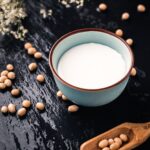 What is it about soy that makes it so controversial?
What is it about soy that makes it so controversial?
Unfortunately the answer isn’t so black and white. Although many health claims have been made as well as negative health effects, scientific research is still lacking in this area and we must take into account other lifestyle factors as well. Soy foods contain a variety of bioactive components, including saponins, protease inhibitors, phytic acid (phytates), and isoflavones. It’s these compounds and what they can do once consumed that cause the controversy.
Also, most soy products on the market tend to be overly processed, genetically modified as well as being exposed to a plethora of herbicides….further heightening its controversy.
Is it really high in oestrogen? Can it affect oestrogen levels in every woman – or some more than others?
The Isoflavones present in soy belong to a class of compounds known as phytoestrogens, plant compounds that have oestrogen-like structures.
These isoflavones are similar in structure to the oestrogen hormone – estradiol. As a result, they can have both weak oestrogen-stimulating and oestrogen-inhibiting effects, depending on the circumstance.
In short, they can activate and/or inhibit oestrogen receptors in the body.
However, the UK Committee on Toxicity (2003) noted that phytoestrogens bind weakly and are unlikely to prevent the function of our endogenous oestrogen (at normal blood levels).
Is it true soy is hard to digest due to phytates?
Soybeans are high in phytic acid (also known as phytates), present in the bran or hulls of all seeds. It’s a substance that can block the uptake of some essential minerals – calcium, magnesium, copper, iron, and especially zinc – in the intestinal tract.
Eating fermented soy like tempeh & miso can have lower levels of phytates, and the process of sprouting them or buying organic and non-genetically modified soy can also reduce their phytate levels.
Are all soy-based products the same – tofu, soy milk etc?
The short answer – No. The real differences are in how the soy is processed – if it’s organic or non-organic, if its genetically modified and also if its fermented. I would recommend that you consume organic, non-genetically modified and ideally fermented soy products – choosing tempeh over tofu for example and choosing miso over soy sauce.
How much is too much – is there a daily limit e.g. 200g tofu?
It really depends on the type of soy product you are eating and what you’re eating it for and if it’s your main source of protein. The FDA recommends 25 grams of soy protein per day as part of a balanced diet.
Are soy products on Britain’s supermarket shelves very processed?
Yes some can be – most tend to be non-organic and genetically modified so my advice is to choose wisely when it comes to soy – ideally organic and non-genetically modified…and opt for fermented sources if you can – for example, tempeh over tofu. Tempeh tends to be less processed and also provides more protein and fibre per serving than tofu.
Some studies say soy can help to protect against breast cancer – is this true?
Most breast cancers are sensitive to oestrogen (also known as oestrogen receptor positive) which means that oestrogen can fuel their growth.
There has been some concern over the consumption of soy and breast cancer, however studies have shown that a diet high in soy may not increase the chances of developing breast cancer and may even reduce that risk.
In one study of more than 73,000 Chinese women, researchers found that those who ate at least 13 grams of soy protein a day (approx. 1-2 servings) were 11% less likely to develop breast cancer than those who consumed less than 5 grams.
My advice would always be to choose organic and non-genetically modified to ensure the highest quality product.
Is soy really that bad for you if it’s been consumed in Asia for generations?
Soy is consumed very regularly in Asia and is part of the typical Asian diet. The soy that’s consumed in Asia however tends to be highly fermented (things like miso, tempeh and natto) and this will play a part (as well as other general lifestyle factors) into its health benefits for certain populations.
